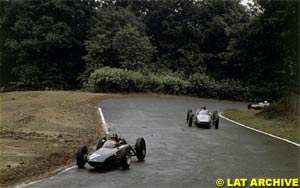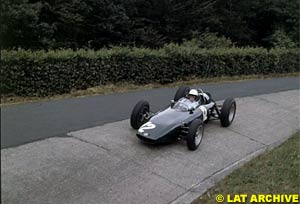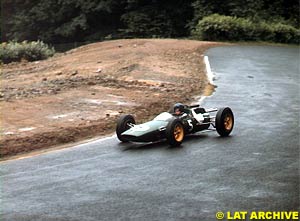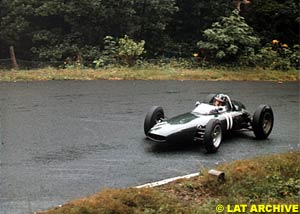
The Legend Factory (1962 Vintage)
Atlas F1 Contributing Writer
Formula One teams arrive this weekend at the Nurburgring circuit, a track that has little - if anything - to do with the original 14.2-mile layout that hosted the German Grand Prix up until 1976. Journalist and historian Doug Nye pays tribute to the Nordschleife by looking back at the 1962 German Grand Prix, a race in appalling conditions that enhanced the legend of the BRM team and their driver Graham Hill
But just for the hell of it - because I am obsessively involved with BRM racing team history right at this moment - I am about to regale you, if you have the patience to plough on - with the inside for-team-eyes only tale of a Formula One World Champion elect's wonderful victory in appallingly wet conditions here, on the Nordschleife forty years ago, in 1962.
Just peruse what follows, and hope that 2002's race engineers and record keepers, and team chiefs, and drivers too, are generating as evocative a race record for the enthusiasts of 2042.
Read on, for this - my like-minded chums - is Formula One from the inside, 1962 vintage at Der Nurburgring.
* First Practice: This took place without Ferrari - on a dry circuit. Graham Hill tried the new and old cars. Both cars touched bottom at the front with two Aeon bump rubbers - and it was necessary to add a third rubber to both. Richie Ginther's car did not bottom.
Both cars seemed to be running well and the practice times returned by Hill and Ginther were 1st and 2nd fastest, nine minutes zero seconds, and nine minutes seven seconds respectively.
Before the afternoon session, Graham Hill expressed the opinion that the new car had superior handling to the old one, in that his old car understeered badly on the slow corners and tended to oversteer on some of the fast ones, whereas the new one understeered far less on slow corners and was neutral on the fast corners. This is the first time the effects of the stiffer 1962 chassis has shown benefits. He also thought that the close ratio gearbox fitted to the new car was more suitable for the Nurburgring.
Ginther, meanwhile, had said that his car was handling well; but he felt that if it could be lowered on its suspension it would be an improvement, and as there was no trace of his car bottoming, this was done - he was just about to set out when we heard of Graham Hill's accident. Ginther was, therefore, sent out to collect Hill, who had however returned in an official car.
On Ginther's return he reported he could not find Hill, but the roadholding of his car was even better. Graham Hill was then sent out in his old car to check its handling and to re-adjust himself after his accident. After practice, the crashed car was recovered - the close ratio gearbox removed from it and fitted to Hill's old car. Before the final Practice session commenced on Saturday there was a shower of rain, so that fast times were impossible.
* Final Practice: Fastest time in this session was put up by Bonnier of nine minutes 12 seconds - followed by G. Hill, 2nd fastest, of nine minutes 13.4 seconds, and Ginther, 3rd fastest time of nine minutes 16 seconds.
Although G. Hill said he was suffering from no ill effects of the accident, he obviously had a stiff neck and a badly bruised chest.
During the pre-race check, it was found that the valve spring retaining circlip on No. 2 inlet valve in Ginther's engine was broken - the small piece was recovered, and as there was still 270degs of circlip still in place and unbroken, the engine was left in place. No other faults came to light during the pre-race checks.
* Race Day: About 1.30 pm. on race day, just as the cars were going out of the paddock, there was a torrential cloud burst, which washed away part of the track. We removed the front roll bars from both cars to make them more suitable for wet conditions. Graham Hill noted that Bonnier's time in the wet had been established on German Dunlop S.P. tyres and wished to race on them. All Dunlop personnel were very much against this. After some argument it was agreed to fit up a set for us to try during the reconnaissance lap, which had been arranged in view of the appalling conditions. When these tyres were produced and fitted to the car, the ground clearance had been reduced by about 5/8", so that they obviously could not be used - a situation which Graham Hill accepted.
After the reconnaissance lap, 1 1/4 gallons of fuel were added to each car before the race, which started 70 minutes late. Clark omitted to switch on his electrical petrol pump and stalled on the line, losing about 20 seconds. During the first lap, Gurney led, with G. Hill closing up; and on the 2nd lap, Hill overtook Gurney in front of the pits, and led for the rest of the race.
On the 10th or 11th lap Graham Hill believed he saw a patch of oil as he approached the main straight and slowed down. Surtees and Gurney either did not see this oil and did not slow down, with the result that the lead of seven seconds that G. Hill had built up by this time was lost. G. Hill said afterwards that it was the hardest race he had ever driven. He thought he could have gone a little faster, but was relieved that this was not necessary.
Ginther subsequently finished 8th, having at one time begun to close on Bonnier, so that we hoped he would overtake
him; but though both Ginther and Bonnier speeded up, Bonnier managed to keep in front; and towards the end of the race, Ginther slowed down and Maggs, on a 4-cylinder Cooper, began to catch him up, though not to a dangerous degree. Ginther afterwards reported that the car gave no trouble, although if he had to race under similar conditions again, he would prefer a car with less camber.
9th August, 1962. A.C. Rudd
Graham would view this Grand Prix "...as one of my finest races up to that time". The camera incident which robbed him of his new BRM P578 'Lightweight' car during practice had been, as he put it: "...rather unpleasant...I appeared round a hedge doing something like 120-130mph when I saw some black object in the middle of the road. Because of my speed and having to cut the corners on this sort of zig-zag downhill road; I could only move about six inches off line, so to prevent my wheels hitting it I ran straight over the top of it. Unfortunately it pierced the oil tank which was just behind the radiator - and back wheels so I spun round and shot along a ditch on the left, tunnelling along like a giant mole at great speed, tearing off wheels and suspension bits, and eventually came to a stop halfway up the other side - lying in the ditch in little more than just the chassis.
"I had only just got out, and was peeping over the top of the ditch with my eyes level with the track, when Tony Maggs (in the second-string works Cooper-Climax) came rushing down the 'Foxhole', hit my oil, spun like a top and bounced end to end off the hedge - destroying his car as well! I ran down the track waving my arms, just in time to save Trintignant from doing the same on all the oil I'd dropped.
"Then I found the shattered remains of the movie camera with film all over the track. It couldn't have fallen off in a worse spot...and of course BRM and Cooper had both lost a car."
BRM Chief Mechanic Cyril Atkins recalled the aftermath: "When Graham finally got back to the pits, he'd told us the car was parked at so and so, but didn't tell us he'd parked it behind a hedge. We went right round the entire circuit - all 14 miles odd - and couldn't find it. 'Aah bugger me', he said - typical Graham - and came round with us and said '...there it is, look', and he'd ended up shooting along behind the hedge parallel with this ditch. No wonder we couldn't find it..."
So far as race day was concerned Graham would write: "It couldn't have been worse - raining cats and dogs. I remember distinctly removing both my front and rear anti-roll bars to find an advantage in the wet - everybody was on the Dunlop D12 rain tyres, so no one had an advantage there. But conditions couldn't have been worse for the tremendous battle between Gurney, Surtees and myself. I don't think more than five seconds separated us for something like two and three-quarter hours. It was a classic race as far as I was concerned - the pressure was tremendous, the conditions were foul; and I'd had that particularly nasty experience in practice. It was probably one of the most tiring races I've ever competed in, and after flying back that night for the Bank Holiday Monday races at Brands Hatch next day, perhaps I shouldn't have been surprised when my reactions seemed a bit slow and I stuffed one of 'Noddy' Coombs's 3.8 Jaguars into the bank!"
For BRM's venerable founder, pre-war hill-climb and road racing star driver Raymond Mays, his team having won the German Grand Prix was particularly meaningful, for this was where the 'Silver Arrows' that he so revered and had longed to emulate had reigned supreme, where Dick Seaman had triumphed pre-war, and where he had raced his ERA... For his generation, the Nurburgring was a motor racing Everest - which his team, the entity he still regarded as his creation, his baby, had just conquered.
"What a moment that was...", he would write, "I felt that the trials and humiliations, the nervous strain, the long days of worry, had all been wiped out by this glorious win." He drove back to his hotel, the Lochmühle in Mayschoss, dined quietly with a few friends...and savoured BRM's vindication.
And - just so that we can all keep our views of modern Formula One money-scales in perspective, consider this gem from an internal memo which BRM team Chief Engineer Tony Rudd wrote - on August 10, 1962, to company owner Sir Alfred Owen:
"The results of this Race, apart from putting us back in the lead in the Manufacturers' Championship, and making our second Grand Prix win, bring us up to a Class I car for Starting Money under the terms of the Monte Carlo agreement. By this we get £1,000 starting money for the 1st car and £900 for the second, as against the £600 and £700 respectively (sic), that we started the season with as a Class III car..."
You see? Everybody inside Formula One today has much for which to thank Mr B.C. Ecclestone...
The Neue Nurburgring circuit - derisively dubbed (by yours truly) the ersatz Nurburgring when it was first used in place of the magnificent and historic old Nordschleife - was memorably described by Sir Stirling Moss at its opening as "Hardly a place on which legends will be made". In recent years Schumacher, M. has memorably come quite close - by some enthusiasts' reckoning - to proving that the Knight's armour shows signs of rust. Even so, nothing can match the magnificence, the splendour, the charm, the brooding majesty, of the old 14.2-mile traditional home of Germany's classic Grand Prix race - the Nordschleife or 'North Circuit' whose still wonderful modernised remains are contiguous with next weekend's venue even today.
 Here, I'm not going to dwell on the old circuit site's fantastic history in this, its 75th anniversary season. I'm not going to wax lyrical about Nuvolari's victory for Alfa Romeo against all the odds and in the teeth of frontier-technology Mercedes-Benz and Auto Union opposition here in 1935. Nor about Fangio's fantastic Maserati 250F fight-back to humiliate Ferrari and the English boys, Mike Hawthorn and Peter Collins here in 1957.
Here, I'm not going to dwell on the old circuit site's fantastic history in this, its 75th anniversary season. I'm not going to wax lyrical about Nuvolari's victory for Alfa Romeo against all the odds and in the teeth of frontier-technology Mercedes-Benz and Auto Union opposition here in 1935. Nor about Fangio's fantastic Maserati 250F fight-back to humiliate Ferrari and the English boys, Mike Hawthorn and Peter Collins here in 1957.
Three cars were taken to the Nurburgring. The suspension set-ups were as arrived at during tests at Snetterton on the 25th July.
 During the afternoon session, he produced his first full flying lap time in the old car, which was eight mins. 50.2 seconds. He then said that he believed the new car would be at least 5 seconds faster, and he set off in the new car to prove this. During his first lap he was involved in the incident with the television camera.
During the afternoon session, he produced his first full flying lap time in the old car, which was eight mins. 50.2 seconds. He then said that he believed the new car would be at least 5 seconds faster, and he set off in the new car to prove this. During his first lap he was involved in the incident with the television camera.
 Ginther was in 8th position, challenging Phil Hill for 7th place. At first Clark appeared to be demoralised by his bad start and gradually dropped back until he was 36 seconds behind the leader. Around the 7th lap he speeded up and by the 11th lap had closed to within 17 seconds of Graham Hill, who then in turn speeded up by six seconds a lap. At the same time, Clark spun twice on the 12th lap and decided to settle for 4th place, dropping back, so that he finished 42 seconds behind.
Ginther was in 8th position, challenging Phil Hill for 7th place. At first Clark appeared to be demoralised by his bad start and gradually dropped back until he was 36 seconds behind the leader. Around the 7th lap he speeded up and by the 11th lap had closed to within 17 seconds of Graham Hill, who then in turn speeded up by six seconds a lap. At the same time, Clark spun twice on the 12th lap and decided to settle for 4th place, dropping back, so that he finished 42 seconds behind.
 Graham had escaped - amazingly - with bruising and wrenched muscles in his neck, chest, arms and shoulders. He returned to the pits clutching the shattered camera and its tangle of film, handing it to RM, who took it straight to the furious John Cooper. Protests and demands for compensation were instantly placed with the organisers and the TV people, RM spending the rest of the weekend embroiled in pursuit of recompense.
Graham had escaped - amazingly - with bruising and wrenched muscles in his neck, chest, arms and shoulders. He returned to the pits clutching the shattered camera and its tangle of film, handing it to RM, who took it straight to the furious John Cooper. Protests and demands for compensation were instantly placed with the organisers and the TV people, RM spending the rest of the weekend embroiled in pursuit of recompense.
Please Contact Us for permission to republish this or any other material from Atlas F1.
|
Volume 8, Issue 25
Atlas F1 Exclusive
Interview with Alan Donnelly
Giancarlo Fisichella: Through the Visor
Articles
The Williams Boys on the Ferrari Man
Irvine's Crunch Time
European GP Preview
The European GP Preview
Local History: the Nurburgring
Columns
The Le Mans Trivia Quiz
Bookworm Critique
Elsewhere in Racing
The Grapevine
> Homepage |